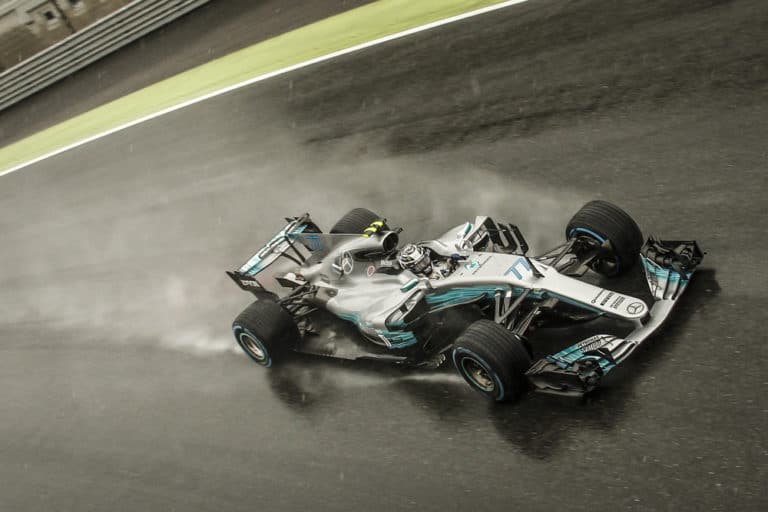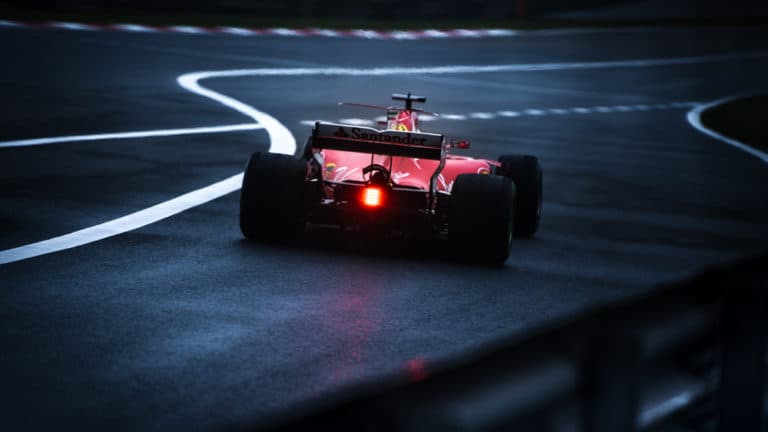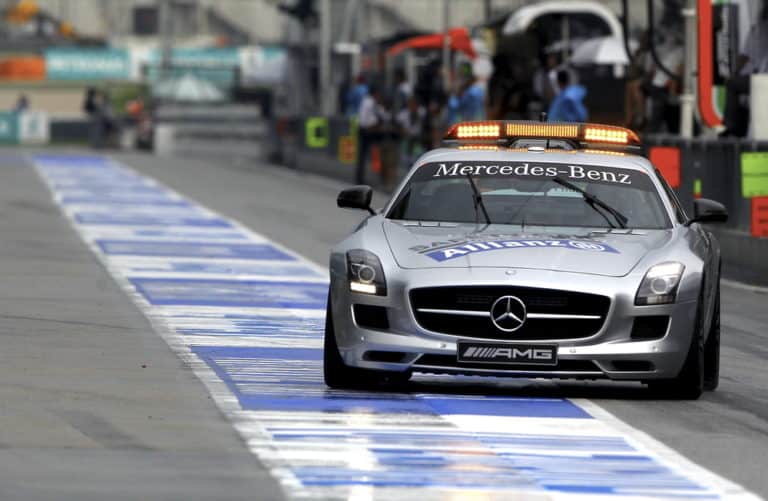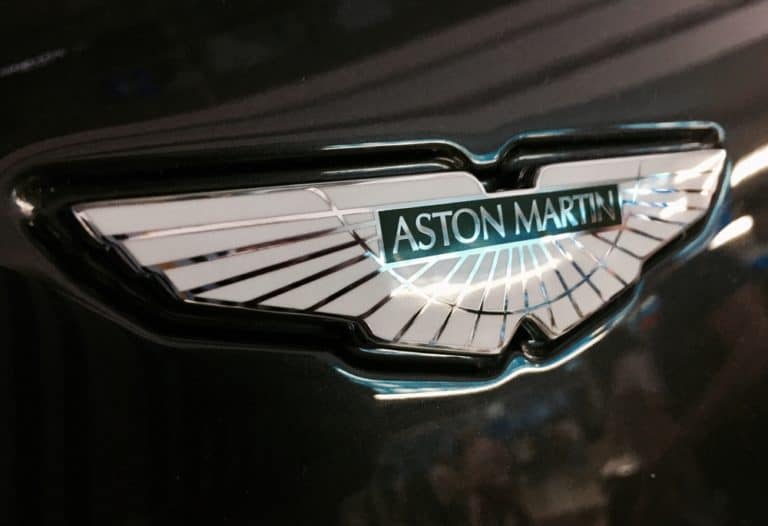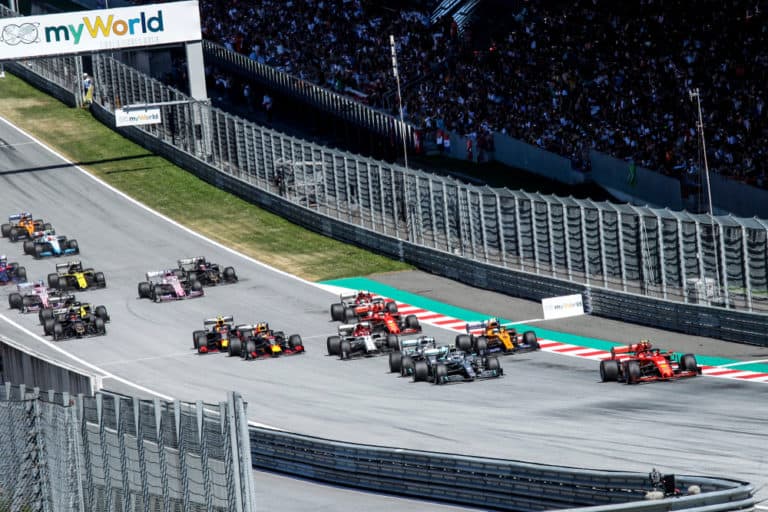Formula One is a big business that earns billions of dollars each year and provides employment opportunities for thousands of people while capturing the imaginations of hundreds of millions worldwide. The logistics are equally impressive; one example is that it uses 33,600 tires every season.
Formula One tires are manufactured as five different dry weather compounds, one intermediate, and one wet weather tire. Three dry weather compounds are allocated for each race weekend and are strictly controlled and monitored to ensure that they are not misused.
The life cycle management of Formula One tires is a complex process involving sending months in advance to other racetracks on separate continents and ensuring that each used tire is fully accounted for and returned to the European Factory.
If you’re looking for some F1 merchandise, check out the awesome stuff at the official F1 store here.
Everything You Ever Wanted To Know Regarding Formula One Tires
Managing the tires is part of the Formula One team’s race planning as engine, setting, driver strategy, engine mode, and all the other seemingly small details that can affect the final points tally.
It’s so important that one of the most senior members of the pit team is a strategy specialist whose job is to predict when the most opportune times are to get out of the car.
It is not shooting a line to say that there have been formula one events in the past where tire strategy has been the deciding factor in determining which car and river won the event.
In this article, we will explain.
- What are the different types of Formula One tires?
- How can tires be used to affect the outcome of a race?
- Why are the new tires so shiny?
- What happens to old Formula One Tires?
What Are The Different Types Of Formula One Tires?
The modern generation of tires for both Formula One and Formula Two races are manufactured by Pirelli.
Pirelli produces seven different compound tires.
- There are five different consistencies of dry-weather tires.
- There is one intermediate (when the track is not fully dry) tire.
- One wet weather with deep treads for use in very wet conditions.
Of the five dry weather (slick) tires that are available, only three will be used during a particular race.
The five tires are designated.
C1 Compound
It Is the hardest compound and best suited for high-speed circuits with fast corners, abrasive surfaces, and high ambient temperatures.
C2 Compound
It is the next hardest compound and still offers capability at high speed, abrasive and hot tracks.
C3 Compound
C3 is the middle-of-the-range compound; in some circumstances, it can be designated the hard tire and the soft tire in others.
C4 Compound
It is the second softest compound suited for colder temperatures, slightly slower tracks, and smoother surfaces.
C5 Compound
C5 is the softest compound, and while it provides the best grip of all, it is also the fastest wearing tire.
The three compounds which are chosen for a specific weekend will be determined by the expected tire wear at a particular track.
The Factors Which Affect Tire Wear
The Amount Of Downforce Used On A Track
Teams will set the car’s aerodynamics on tracks with fast corners and shorter straights to produce more downforce. The downforce is used to “squash” the car down onto the track, which can travel through high-speed corners with more traction.
There are two problems with this setup.
- There is greater friction between the road surface as well as the air, reducing the top-end speed.
- Because the downforce pressure is greater, the tires wear out faster.
Formula One cars with a natural high downforce bias will do well on these tracks.
Hungary, Imola, Spain, and Monaco are all examples of high downforce tracks.
Mexico, Canada, Baku, Monza, and Austria are all considered to be “low” downforce tracks.
How Abrasive The Track Surface Is
While some tracks may look like billiard table surfaces on the television, this is not the case.
Some track designers have been forced to use a more abrasive surfacing material to better cope with conditions at that site. In other instances, the track is wearing and beginning to need to be resurfaced.
Whatever the reason, these tracks have higher friction factors, and as a result, the tire wear is greater.
Silverstone, Spa, and Suzuka are all examples of abrasive tracks.
The Temperature At The Track
The hotter a track temperature is, the greater the stress which is placed on the tire compound.
In tracks situated in very hot climates, softer compound tires suffer a higher degradation rate. The higher temperature causes the tire to heat up faster and quickly impacts performance. A tire in this condition will quickly “fall off” and lose traction.
Bahrain, Abu Dhabi, and Saudi Arabia are a few examples of hot tracks.
How Are The Tire Compounds Selected?
Understanding that certain tracks will require a harder compound means that the softer (and better gripping) tires will not be able to be used.
When race weekend is being planned, the chosen tires are given the classifications.
- Hard Tire
- Medium Tire
- Soft Tire
The three suitable compounds that meet these criteria will be selected from the five available compounds (C1-C5).
Therefore, the following example is where the designation of the tires for a track that may suit a harder compound tire.
The tire compounds C1 – C3 are chosen and will have the following designation.
- C1 designated the “Hard” tire.
- C2 designated the “Medium” tire.
- C3 designated the “Soft” tire.
At another track, which is suited for a sifter compound, the following designations may apply.
- C3 designated the “Hard” tire. Remember this was the soft tire in the previous example)
- C4 designated the “Medium” tire.
- C5 C3 designated the “Soft” tire.
How Can Tires Be Used To Affect The Outcome Of A Race?
As we stated before, it is one of the essential strategies which a Formula One team will use.
Tire Choice In Advance
Each Formula One team receives 13 sets of slick tires for their use over the weekend; this includes
- The weekend had two sets of the compound designated “hard tires” for the weekend.
- Three sets of the compound designated “medium tires” for the weekend.
- Eight compound sets are designated “soft tires” for the weekend.
- Four sets of intermediate tires.
- Three sets of full wet weather tires.
For the first Free practice Session (FP1), teams must nominate one set of tires that must be used within 40 minutes of the start of free practice session one.
After use, this and one other set are returned to Pirelli within two hours after FP1 has ended.
At the end of FP2, a further two sets are handed back to Pirelli.
Similarly, at the end of FP2, another two sets are handed back to Pirelli.
Assuming no intermediates or wet tires have been used, the teams are left with seven sets of dry-weather tires to run the qualification and main Grand Prix.
The teams are free to use these remaining sets as they wish.
Undercutting And Overcutting
If a team has a different tire wear rate than their competitors, they can use the pitstop and tire change strategy to their advantage.
The terms used for this are
- To perform an Overcut.
- To perform an Undercut.
Perform An Overcut
In this instance, a team that may be struggling to overtake, but believes they have a faster pace, will let the team ahead pit first.
While the competition is pitting (a process that takes between 18 and 23 seconds), the team performing the overcut will run as fast as their tires allow and try to increase the gap when the other car returns to the track by more than the time it took to pit.
Depending on the tire compounds chosen, it may also take the other car a lap to achieve the increased top speed benefit of ye new tire while they wait for it to “switch on.”
If they are successful, the team performing the overcut will have a time safety margin, and if the pitstop goes well, they should rejoin the track ahead of the other team.
Another advantage of an overcut is that when the team rejoins the race, they have a set of tires that is X number of laps newer than the other team, which will bode well for them later in the race when the other teams tires are wearing.
Perform An Undercut
As the name implies, an undercut is the opposite of an overcut.
In this case, a team (Team A) may be just behind a competitor (Team B).
Team A pits and hopes for a very fast pit stop when the gap to team B is close enough.
When the driver (Team A) returns to the track, they have newer tires and hopefully will have a faster pace than Team B. On their return to the track, every second that they can close to Team B is an advantage to them.
The aim is for team A to close the time gap to less the time it takes to pitstop. Therefore, when team B returns, they are automatically ahead with tires at optimal temperature, which can continue with an advantage until the team B tires have warmed as well.
Use A Different Tire Strategy
It is often a gamble to use a different tire strategy than the competition, but sometimes it is worth the risk.
An example of a different tire strategy would be when the rest of the field starts the race in the compound designated “Medium” for the weekend, and instead, the team starts on the “Soft” compound.
The team starting in the soft would work on the premise that the ace in the Soft tire would be significantly faster than the mediums, and they would aim to pull away from the pack to set a buffer between themselves and the rest.
When they must inevitably pit sooner than the rest, they will perform an undercut and use a pair of Medium compounds to rejoin the track.
On this basis, they would hopefully be less than a pitstop behind the leader with a newer set of tires than the others.
By the time the leaders do pit, the team would hopefully have gained a lot of time and so end up leading the race – that’s the theory. There are so many variables that may come into play that could end up offsetting any advantage which was hoped for.
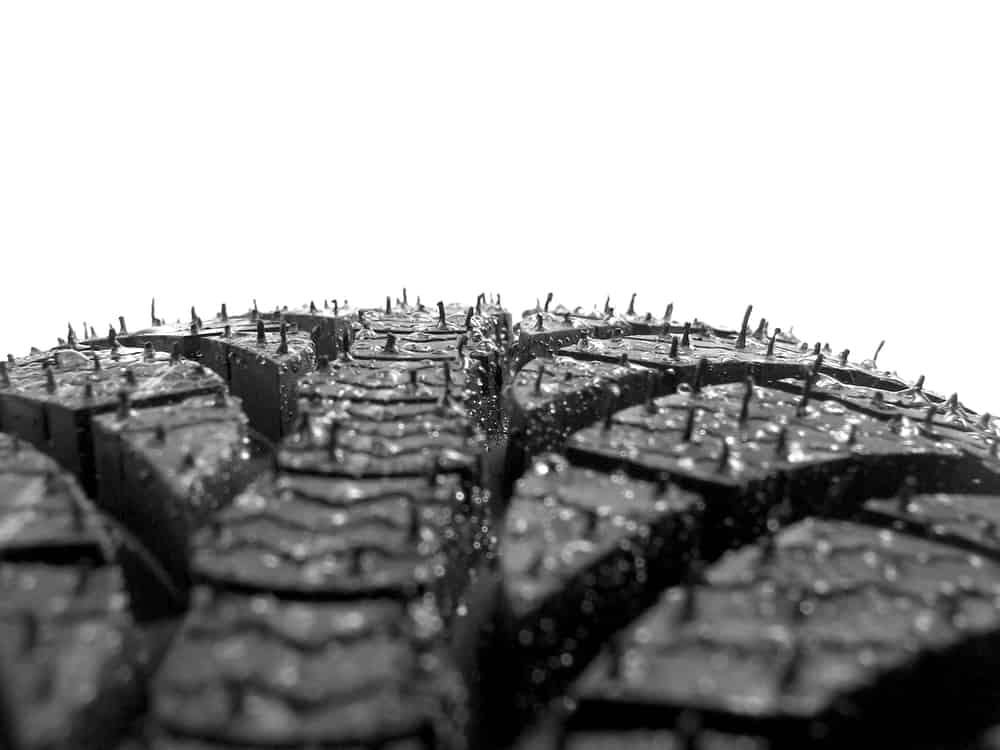
How Many Laps Will An Average Formula One Tire Last?
Unfortunately, this is a very difficult question because it depends on many variables.
With the understanding that heat, abrasive tracks, and downforce levels will all impact the result, the following table lists the number of laps that Pirelli intended for the tires to last.
| Tire Compounds | Minimum Number Of Laps The Tires Were Designed For | The “Hoped For” Number Of Laps The Tires Were Designed For |
| C1 | intended to last 30 laps | Hoped to last 50 laps |
| C2 | intended to last 30 laps | Hoped to last 30 laps |
| C3 | intended to last 20 laps | Hoped to last 30 laps |
| C4 | intended to last 20 laps | Hoped to last 30 laps |
| C5 | intended to last 10 laps | Hoped to last 20 laps |
Why Are The New Tires So Shiny?
Pirelli first launched the new “shiny” tires in 2018 for use on the formula 2 series cars. These new technology tires were introduced to Formula One in the following 2019 season.
The shine is caused by the new chrome-lined mold, which produces a very clean, unblemished surface with a reliably fault-free surface.
The new manufacturing method consists of the following steps.
- Step One – The Bead Wire is wound to form a ribbon
- Step Two – The tire carcass is molded from thin textile fiber cords.
- Step Three – The bead (now molded into the carcass) is directly joined to the tire belt.
- Step Four – The outer shell, tread layer (with slicks and no tread) is formed.
- Step Five – The components are assembled and placed in a chrome-lined mold.
- Step Six – The tire is removed from the mold and has the shiny surfaces being discussed.
Why Do Formula One Teams Scrape The Tires?
When the racing weekend starts, the tracks are free of debris and spent rubber; however, as the race and practice events continue through the weekend, a layer of tire debris is laid down onto the surface.
As the Formula One cars run over this debris, the tires pick it up. It becomes more frequent as the tires heat up and the tread surface becomes more malleable.
The teams will try to reuse some of the different compound tires. Unfortunately, even if the tire is useable, it is covered in a gum-like substance, all the melted rubber which has been picked up off the track surface.
The surface irregularities must be rectified before the tire can be used again.
The process of cleaning the “gum” of the tire’s tread surface is called scraping.
The benefits of scraping the tire include.
- The gum-like debris is cleaned, making the surface smoother.
- Scraping the tire has the effect of reducing the heat buildup, making the tire more heat efficient.
- Scraping the tire reduces degradation and wear.
- Scraping the tire reduces the overall tire weight.
- Scraping the tire flattens the tread layer, which increases the tire surface area and therefore improves traction.
- If the Formula One team were not allowed to scrape the tires and reuse them, they would not have enough to last the weekend.
When the teams and Pirelli scrape the tires, they can analyze the wear and to verify if the predictions that Parelli made were accurate or not. It helps the team to work out the tire strategy for the race.
Pirelli also scrapes the tire for an analytical purpose which helps them build a databank of statistics that they can use for future developments.
How Do Formula One Teams Scrape The Tires
The team technicians use a modified heat gun to scrape the Pirelli Formula One tires.
The tool produces a jet of super-heated steam, which melts the tread layer’s outer part and all the gum-like debris.
When the rubber has started to melt, the operator uses a scraper to remove the melted coating.
It is a job that requires a high degree of skill and care to ensure it is smooth and even. The remaining tire surface must support a Formula One car traveling at a speed approaching three hundred km/h, braking with high G-forces, cornering, and powering out again.
Because of this, it is vital that the scraping process is done properly and that the tire ends up in optimal condition.
What Happens To Old Formula One Tires?
Despite what you may have heard, old Formula One tires do not end up on a landfill somewhere in e middle of nowhere. Formula One aims to be a responsible citizen of planet earth and is actively working to reduce the sports carbon content and emissions score.
The sporting body is aiming to be carbon neutral by 2030.
To achieve this, the sport handles the end-of-life journey of the tires as follows.
During the Free Practice sessions, six tires are handed back to Pirelli, and the rest are returned to the Pirelli tent at the end of the Grand Prix.
Each tire is individually coded, and as they are returned, the codes are scanned into the system to ensure that they have all returned.
Over the weekend, the 20 teams will have been provided with 1,600 tires, which Pirelli mounted onto the wheels supplied by each team.
Once the returned tires are administered, they are dismounted from the wheel rims, loaded into a container, and sent back to the Pirelli factory. An interesting factoid is that Pirelli uses more trucks than the teams themselves.
A dedicated fleet of trucks transported the tires to and from the races if the race was in Europe. If the race was held on another continent, they are shipped back to Pirelli in a conventional container.
When the tires arrive at Pirellis’ factory, where they are crushed, samples are taken for testing and further analysis.
When the testing process is complete, the rubber tires are melted down, after which several industries use them.
Each tire is shredded and melted in a controlled process within the plant. The shredded rubber is melted and reduced into small rubber pellets.
The pellets are processed to manufacture “tire-derived fuels,” used by the following industries.
- The Paper and Pulp Industries
- The Cement Manufacturing industry
- Electric Power stations and the related utilities
- Industrial Boiler
- As fuel for Energy Facilities(including factories such as Pirellis’s own plant)
The EPA (Environmental Protection Agency) has acknowledged all of Pirelli’s efforts and has stated that one of the most environmentally sustainable methods for disposing of a very difficult substance such as a river. Considering that the sport (excluding Formula 2) uses 33,600 tires every season, the steps they have taken were required.
Formula One is working very hard to ensure that it does not cost the planet and is working hard to reduce damage to the environment caused by the enormous number of tires used during a year. Tire scraping and tire cycling are two ways that this goal is achieved.
Conclusion
From the time a Formula One tire leaves the mold in the Pirelli factory, it is continually tracked and monitored until it is eventually returned to the tire manufacturer for eventual disposal. After the tires have been used, they are recycled into rubber pellets and used in various industries.
Not only does tire management form a major part of formula one team strategies, but the management of the tires through their lifetime follows the goal that Formula One will become carbon neutral and fully sustainable by the year 2030.

